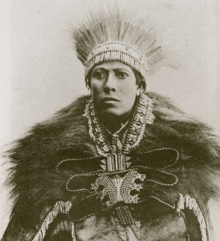Balcha Safo
| Balcha Safo | |
|---|---|
 | |
| Born |
1863 Chebo Midir, Ethiopia |
| Died |
1936 Guráge, Ethiopia |
| Allegiance |
|
| Years of service | 1880s–1930s |
| Rank | General |
| Battles/wars | First Italo-Ethiopian War, Second Italo-Ethiopian War |
Dejazmach Balcha Safo (Amharic: ባልቻ ሳፎ?; 1863 – 6 November 1936), popularly referred to by his "horse-name" Balcha Aba Nefso (Amharic: ባልቻ አባ ነፍሶ?), was an accomplished Ethiopian military commander, who served in both the First and Second Italo-Ethiopian Wars.
Although he came from a non-aristocratic background, he was made a dejazmach. Balcha also became a provincial Governor (Shum), and eventually became a key member of the conservative provincial elite who, in the 1920s, were often at odds with the modernising reforms and rising power of the Regent, Ras Tafari Makonnen (later Emperor Haile Selassie I). Tafari would force Dejazmach Balcha into retirement, albeit an honourable one, in 1928, from which he would emerge in 1935 to fight the Fascist invaders, by whom he was killed in 1936.
Biography
Early career
Balcha was found on a battlefield in Gurageland after having been emasculated, which at the time was the usual fate of defeated soldiers. He came to the notice of Emperor Menelik II, who brought him back to Addis Ababa where Balcha was educated.[1] Balcha is from an Oromo descent; 'Balcha' means 'taming, assimilating or making familiar with' in Afaan Oromo.
He distinguished himself at the imperial court and showed particular skill in military exercises and theory. He made his reputation, according to oral tradition, in the Battle of Mek'ele,[2] and later at the Battle of Adwa (March 1, 1896), and was rewarded with elevation to the aristocratic status of dejazmach.[3]
From 1898 to 1908, Balcha was Shum of Sidamo province. After the death of Dejazmach Yilma Makonnen in 1907, he became the Shum of Harar from 1910 to 1914. From 1917 to 1928, he again served as Shum of Sidamo.
Conflict with Haile Selassie
A conservative who had been loyal to the memory of the deceased Emperor Menelik, Balcha was one of the leading nobles who challenged the growing power of the regent Ras Tafari (who later became Emperor Haile Selassie). A blunt old warrior, he did not trust the young Emperor, who was an advocate for modernizing Ethiopia. In a deft political maneuver, which has since been seen as an example of Haile Selassie's genius, in 1928 the Emperor invited Balcha to the capital for a feast in Balcha's honor. Balcha arrived 11 February with several thousand men, and spent the evening "generally insolent and threatening in conversation."[4] The Dejazmach's lieutenants were made so nervous by the old man's misbehavior that they privately met with Ras Tafari to disavow any prior knowledge of his possible violent actions.
Meanwhile, the regent sent Ras Kassa Haile Darge to Balcha's camp, where he paid off the soldiers Balcha had left there. At the same time the Emperor appointed Dejazmach Birru Wolde Gabriel to replace Balcha as governor of Sidamo. These simultaneous acts deprived Balcha of his ability to resist, a loss he discovered only after he returned to the camp.[5] After evaluating his limited options, on 21 February the Dejazmach humiliated himself before the regent.[6]
Death
When Italy invaded in the Second Italo-Abyssinian War, Balcha Safo came out of retirement to fight against the Italians.[3] Major Mesfin Seleshi, an agent of the imperial government in exile who was coordinating resistance in occupied Ethiopia, writes of his fate in a letter to Haile Selassie I thus:
The enemy went as far as Gurage, where his Excellency Dejazmatch Balcha lives, and campaigned against him. The people betrayed him, and all his men were annihilated. He and two of his servants, three people all together, were surrounded. A white man came to him and asked, are you Dejazmatch Balcha? When he said yes I am, the white man said, surrender your arms, and untie your pistol [belt]. Dejazmatch Balcha said, 'I am not here to surrender my arms', and he killed the white man; then, he and his two servants died instantly without having much suffering.[7]
See also
References
- ↑ Paul B. Henze, Layers of Time (New York: Palgrave, 2000), p. 190 n. 8
- ↑ Harold G. Marcus, The Life and Times of Menelik II: Ethiopia 1844–1913, (Lawrenceville: Red Sea Press, 1995), p. 166
- 1 2 Haile Selassie I. My Life and Ethiopia's Progress. Vol. 2, 1999, page 32.
- ↑ Harold G. Marcus, Haile Sellassie I: the Formative Years (Lawrenceville: Red Sea Press, 1996), p. 89
- ↑ Anthony Mockler, Haile Selassie's War (New York: Olive Branch, 2003), pp. 7f; Bahru Zewde, A History of Modern Ethiopia, second edition (London: James Currey, 2001), pp. 132f.
- ↑ Marcus, Haile Sellassie, p. 90. Haile Selassie's bloodless victory over Balcha is presented as an example of concealing one's intentions in Robert Greene, The 48 Laws of Power (New York: Penguin, 1998), pp. 25–27
- ↑ My Life and Ethiopia's Progress. Vol. 2, 1999, page 79.